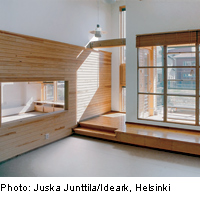Child-Care Facilities in Finland

Before entering school proper, most children in Finland have already gone through one of the best infant-care systems in Europe. Nur-sery and preschool education in that country is based on a law dating from 1973. More than 50 per cent of children under the age
of six benefit from this facility, and roughly
95 per cent of all six-year-olds receive preschool teaching. Most Finnish children learn basic social accomplishments in crèches and kindergartens, many of which have close links with schools that are either in the same locality or are close in the sense that the transition from one to the other is a logical continuation. In recent times, one can observe a process in which schools and day-care facilities are grouped together in larger ensembles.
Today, smaller towns and communities have to administer their resources on a more autonomous basis than in the past, and the mantra of “centralizing, economizing, outsourcing” that was formulated after the recession at the beginning of the 1990s is still prevalent in many cases today. Developments of this kind have their advantages, too, of course, since larger educational establishments have greater resources for equipment and staff.
of six benefit from this facility, and roughly
95 per cent of all six-year-olds receive preschool teaching. Most Finnish children learn basic social accomplishments in crèches and kindergartens, many of which have close links with schools that are either in the same locality or are close in the sense that the transition from one to the other is a logical continuation. In recent times, one can observe a process in which schools and day-care facilities are grouped together in larger ensembles.
Today, smaller towns and communities have to administer their resources on a more autonomous basis than in the past, and the mantra of “centralizing, economizing, outsourcing” that was formulated after the recession at the beginning of the 1990s is still prevalent in many cases today. Developments of this kind have their advantages, too, of course, since larger educational establishments have greater resources for equipment and staff.
